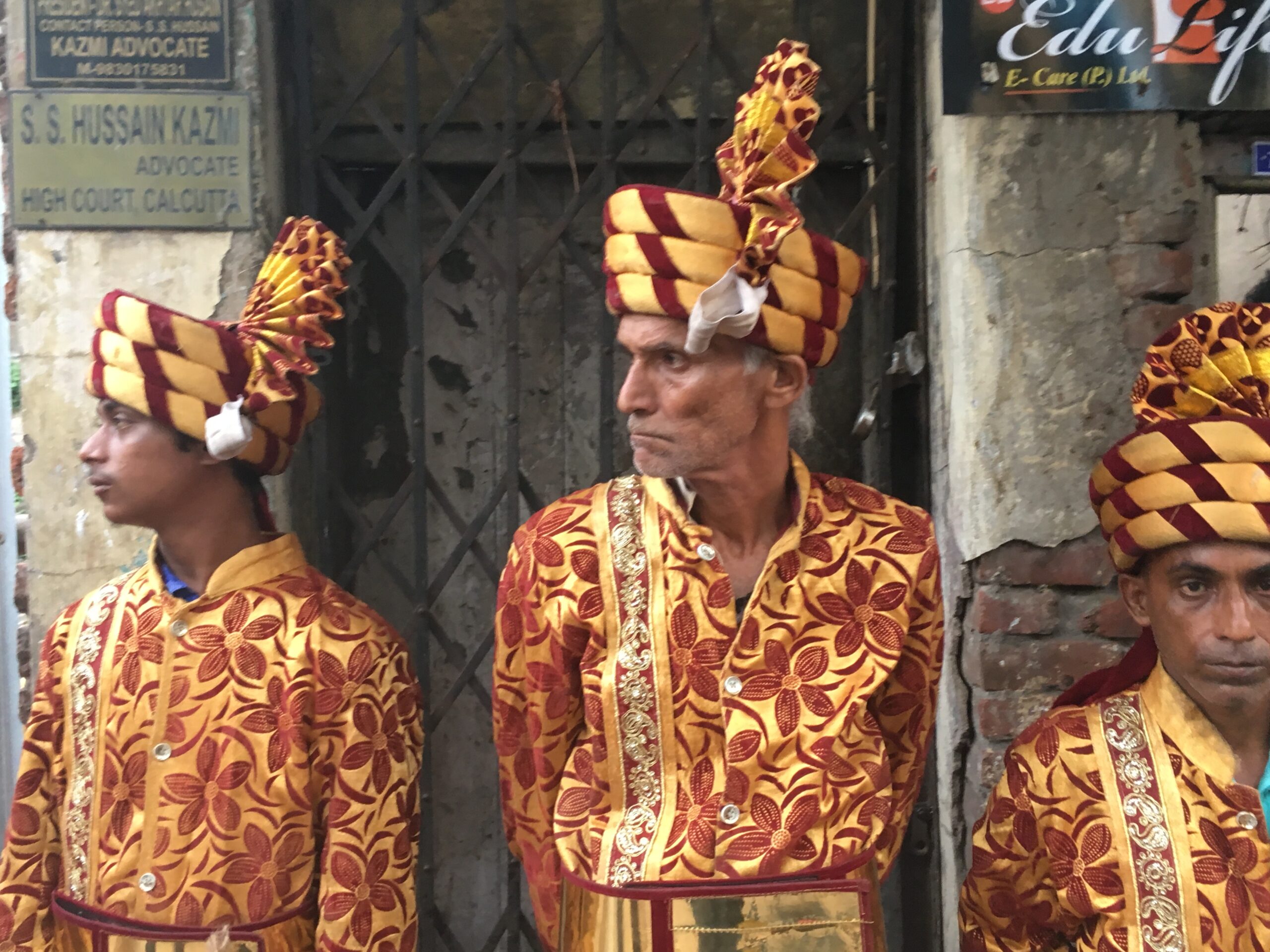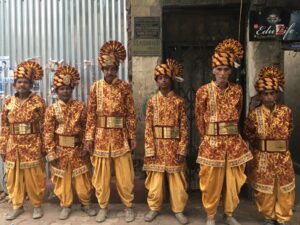
“Name and fame,” Mohammad Sabir said in English, shouting over the noise of the traffic. Manager and occasional trumpet player for one of dozens of marching bands for hire in Kolkata, India, he was describing the glamor that once compelled families across the city to hire bands like his.
Fifty-year-old Master Sabir, as bandleaders are known, was sitting behind his desk in a pink, threadbare shirt. A goat was tied to the electricity box out front, barefoot children raced past, and, nearby, bidi makers sat chopping dried tobacco by hand. According to my phone, it was only 103 degrees, but the reported “feels like” had hovered between 118 and 125 for days, and it was sometimes hard to breathe. This was in May of 2019, halfway through Ramadan and an hour before iftar; Sabir had not eaten or taken a drink of water all day.
Once the cosmopolitan capital of the British Indian empire, Kolkata (formerly Calcutta) retains a lavish, if dilapidated, grandeur. Particularly in the older neighborhoods, crumbling, palatial nineteenth-century villas with louvered shutters and wrought iron balconies fill entire city blocks, including those along Mahatma Gandhi Road, where I was sitting with Sabir. Previously known as Harrison Road, it was the first street on the subcontinent to be lit with electric streetlights. More recently, a 2019 traffic study named MG Road the slowest street in India. Clogged with hand-painted city buses, the occasional herd of sheep, and a wooden tram that has been wobbling by since 1902, MG Road reflects both the faded opulence of Kolkata’s past and a stubborn resistance to going anywhere in a hurry, including the future.
In addition to Sabir’s India Band, the marching band district along MG Road included Calcutta Band, Kolkata Band, Ashok Band, three different Mahboob Bands (who may or may not have been cousins), Azad Hindustan Band, Bharat Band, Jahur Ali Band, Mahuaa Band, Bengal National Band, and Old Kolkata Band, to name but a few. With silver trumpets and dented tubas hanging behind their smudged glass cabinets, the storefronts sat cheek by jowl, one after the other, for more than a kilometer.
In Indian weddings, the groom traditionally approaches the bride’s house in a procession known as the baraat. On horseback or in a decorated car, he often arrives with an “English-style” brass band. Similarly, after Hindu holidays honoring different gods and goddesses, such as Durga Puja, the clay idols are paraded through the streets, frequently accompanied by a band, before the statues are lowered into a river or lake.
Ethnomusicologist Gregory D. Booth has compared marching bands on the subcontinent to cricket. “Like brass bands,” Booth writes, “the game arrived in India with the British and then, beginning in the eighteenth century, proceeded to acquire a specifically Indian life of its own.” With trumpets, clarinets, and snare drums, Indian marching bands now generally specialize in Hindi film classics. Some bands wear flashy, impeccable uniforms and dance as they play, as can be glimpsed in the edgy, Delhi-based TV show Made in Heaven, in which the band appears on screen almost like party motivators, a frenetic joy exploding out of their tubas. Other bands, especially in more rural areas or smaller towns, are far more ragtag, with musicians in their shirtsleeves, performing with a kind of perfunctory duty, not unlike an office worker going to the post office.
In Kolkata, I found the music raucous and wonderfully overstated, with a bass drum and an irrepressible optimism that rattled the sidewalk. Less virtuosic than a New Orleans brass band, less choreographed than an American high school band on a football field at halftime, the sound was buoyant and clamorous. In the late afternoons, during the springtime wedding season, clarinet players and drummers practiced on the street, and a loose, but not improvisational, effervescent pounding echoed up and down MG Road.
According to Sabir, India Band had been in business for five generations, since “British times.” Sabir joined in 1982, when he was fifteen, after learning music from his father, who played the clarinet. His family came from the nearby rural state of Bihar, which is why Sabir spoke Hindi instead of Bengali; his ancestral village was near the site of the ancient Buddhist university Nalanda. Though he lived in Kolkata, sending his kids to school here, the men in his family returned to their village to get married and during annual lulls in business.
Yawning in the languor of the heat, Sabir raised his arms overhead, reminiscing about playing with his father on Saraswati Puja, the February celebration of the Hindu goddess of music and learning. His favorite song, he said, was the bright but romantically alluring “Baharon Phool Barsao,” which rejoices in the “shower of flowers” that is the arrival both of spring and of a beloved, from the 1966 Bollywood film Suraj.
But Sabir admitted that the culture was changing. More couples were choosing “love matches” over arranged marriage, which, he said, could hasten the whole event and result in skipping over some traditions, including the baraat. Other times, young people might prefer a DJ. Worsening traffic, too, had made it harder, according to Sabir, to pay off the police for permits to play in the street. He now hired only sixteen or seventeen musicians for the largest celebrations, as opposed to the fifty or seventy that used to be standard. But he also appeared undeterred. “Now, we have ready-made clothes,” Sabir said, “but people still like to go to a tailor. Now, we have prerecorded music, but people still like to listen to a band.”
In 2019, I was living in Kolkata on a research fellowship and teaching a writing class at Presidency University, around the corner from MG Road. For months, on my way to and from the metro, I’d been captivated by the seeming incongruities: By the lucidity of a clarinet over the shrill, relentless honking. By the attentiveness with which, in the early morning, some musicians washed their blue or orange velour uniforms at the municipal handpump, turning them inside out before hanging them over the wrought iron divider that cut down the middle of this otherwise dusty, sooty street. By watching as men buckled up one another’s cummerbunds and adjusted the fit of their white pleather spats in this tumbledown neighborhood where many men wore thin rubber flip-flops if they wore any shoes at all. Yet, to me, the most notable fact was that, while marching band business relies on weddings and puja immersions—two of the most momentous customs in Hinduism—in Kolkata, all the marching band members were Muslim.
On one hand, art forms in India have, for millennia, reflected the mingling of different cultures, histories, and religions. After Alexander the Great invaded in the fourth century BCE, for instance, some facets of Buddhist architecture and iconography, from Swat Valley in modern-day Pakistan all the way to the east coast of India, developed a clear Hellenistic style, the Buddha then looking not unlike a Greek philosopher. During the Moghul era, before the riches of Urdu poetry developed, centuries of Persian-language literature often imagined the Indian landscape as resonant of that in Iran. Hindustani classical music has always been “deemed to have” what Amit Chaudhuri, in his book Finding the Raga, describes as “some religious content.” Yet the realm of musical performance has also been, Chaudhuri continues, “dominated by Muslim ustads,” ustad being an honorific title reserved specifically for Muslim masters of classical music. Transcendent collaborations, such as that between Ravi Shankar and Ali Akbar Khan, embody and reflect the interfaith synergy that has long characterized Indian music. And in Bollywood cinema, arguably India’s most popular art form, a Muslim elite has always been in the spotlight, on screen and across the industry, especially among its A-list heartthrobs.
On the other hand, it is precisely this inclusive, interreligious history that has come under attack in twenty-first-century India. As I first sat down with Master Sabir in 2019, India was in the midst of national elections. Up for re-election was Prime Minister Narendra Modi, the right-wing Hindu nationalist leader of the Bharatiya Janata Party (BJP), under whom violence against Muslims has proliferated. Peddling a kind of Make India Great Again narrative, Hindutva ideology relies on an ancient identification with Aryans as superior to all other ethnicities as well as a mythic distortion of Indian history that positions everyone other than Hindus as outsiders.
In addition to killing journalists, rewriting history books, and throwing dissidents in jail, Hindu nationalists across the country were also gaining strength by assaulting Muslims with impunity. Beatings were often filmed, murders were shared on WhatsApp, and the spread of online hostility and incendiary misinformation was intensifying. The same week I met Sabir, Arundhati Roy presented the PEN Freedom to Write lecture in New York City. “Although violence against Muslims is not new …” Roy said, since Modi was initially elected in 2014, “India has distinguished itself as a lynching nation.”
Of India’s roughly 1.34 billion citizens, about fourteen percent, or 180 million people, are Muslim, making India the third largest Muslim country in the world. Because of geographic, linguistic, class, and caste differences, Indian Muslims cannot be described as a monolith. And yet, systematic inequality has kept many Muslims disenfranchised for decades, with consistently high rates of poverty; low rates of literacy; and rare representation within local, state, and national government.
Modi himself originally gained international notoriety in 2002, during the Gujarat pogrom, which erupted in retaliation for the death of fifty-nine Hindu pilgrims on a burning train (a subsequent government investigation ruled the fire an accident). In the ensuing mob violence, at least one thousand people were killed with gruesome vengeance, the majority of whom were Muslim. An estimated two thousand Muslim homes and business were destroyed, and some 150,000 people displaced, becoming refugees within their own cities. Then chief minister of the state, Modi was widely believed to have, at best, failed to intervene and, at worst, encouraged the carnage while preventing police intervention. For this assumed complicity, the U.S. denied Modi a diplomatic visa for nearly a decade, until he was elected to lead the entire nation.
These days, anti-Muslim rhetoric and policy are generally acknowledged to be more oppressive than ever, a threat not only among neighbors but also to India’s secular constitution and its democracy, the largest in the world. One colleague of mine at the university, who asked not to be named, called the situation “very grim.”
And yet, Sabir, who had an air of gruff clarity, seemed unfazed—by the heat, by the fasting, and by the elections. “Like a racehorse is born to race,” he said of making music, “the profession is in our blood.” Outside his storefront, the honking came to a crescendo as a pack of motorbikes swarmed behind the tram. As his dyed black hair fell across his forehead, Sabir grew almost defiant, his hands in fists on the desk. In a low, gravelly voice, he was unwavering. “We are born to play.”
When I first sat down with Master Sabir, in May, I wasn’t looking to tell a story as much as I was hoping to hear one. During the elections, I began meeting with band managers, at least in part, to combat my own despair. As the U.S. and India each quivered on a fulcrum, tipping toward authoritarianism, I craved ways of being and thinking that provided a counterweight, and I yearned not so much for optimism as for complexity. For interactions and insights that, yes, resisted the suffocation of nationalism, but also stepped outside of those tropes altogether. I was drawn to the marching band music because it was music. Because the drums created a commotion and snapped my attention into the present. Because I wanted to turn toward what shook me awake and hurt my ears and made me smile despite myself.
Throughout that summer, I talked with over a dozen band managers, all Muslim, and a handful of customers, all Hindu. Though I speak some Hindi, I do not speak Bengali, the dominant language in Kolkata, and I often relied on two different bilingual interpreters. Seemingly wanting to avoid anything that could be interpreted as conflict, each separately and privately pleaded with me not to ask explicitly about anti-Muslim sentiment. For a country in the throes of what Human Rights Watch has blatantly labelled “Muslim hate,” I repeatedly encountered a stilted silence around that hate.
But, as an American, I often wondered how much my own identity affected what was revealed or obscured. What could be discussed versus what must be withheld. I’d been regularly spending long periods of time in India for twenty-five years, primarily in Sabir’s home state of Bihar, in the rural Hindi Belt or so-called “cow belt” of northern India. Particularly in the wake of the 2008 Mumbai attacks, when ten members of a terrorist organization from Pakistan killed 166 people over three days, some of my Bihari Hindu friends grew openly brazen in their bigotry. One friend refused to go to the movies with me the summer after the attacks, citing “too many Muslims” at the theater. But at the same time, my Bihari Muslim friends in the same town were quick to reassure me that everything was fine. That there were no problems.
Since arriving in Kolkata, in late 2018, I was not surprised to encounter similar friction. More than one mother at my daughter’s school complained to me, under sun umbrellas in the sweltering heat of afternoon pickup, that Muslims were to blame for overpopulation. “If they can afford five children, they have fifteen,” was a common interjection. Cab drivers sometimes eyed me in the rearview mirror, warning me that Muslims were murderers who wanted to commit Jihad.
Although I pushed back, I also felt implicated, certain that the United States’ own legacy of Islamophobia, war, and travel bans contributed to the assumption that I would be sympathetic to such claims. I sensed that the country as a whole was struggling to openly discuss, in any language, its own brutality, and as an American, I found familiarity in that, too.
In June, I went back to see Sabir. By then, the BJP had won in a landslide, and instead of the oppressive tension of waiting for the elections, there was the oppressive tension of waiting for rain. In the soupy, sultry heat, two of Sabir’s sons were also in the office that day. Mohammad Mahboob, sixteen, and Mohammad Ali, twelve, sat next to me on a bench, at the storefront on MG Road, their eyes darting back and forth like ping-pong balls, from their father; to Preetam, my interpreter; to me. But when a mobile phone between the boys buzzed, I got distracted, recognizing the ringtone as the opening ditty of the J Balvin megahit “Mi Gente.”
Reggaeton was newly huge in India. My husband told me that “Taki Taki” played nonstop at his gym, and I often heard it blasting out of car windows when stuck in traffic. But not until that moment did it occur to me that perhaps the biggest threat to the future of the marching bands was not Islamophobia but global pop culture. How did old men with tubas, I wondered out loud, compete with the raunchy, synthesized allure of Cardi B rapping in stilettos?
“Bollywood,” Sabir said slowly and with precision, “is a blessing.”
“Even new films still show the baraat led by a marching band,” he explained. “So people have that image as a proper wedding. They might hire a DJ for other events, but for the baraat, there needs to be a band.”
Writing over twenty years ago, film studies scholar Sumita S. Chakravarty explained that “the politics of film culture in postcolonial India … is also a politics of nostalgia, a genealogy of lost ideals.” Bollywood, in other words, remains more Indian than India itself, at once exaggerating and reducing a messy, complex reality into a single national identity. A linear narrative. Bollywood weddings, in particular, are not just the happy ending for one fictional couple, but the triumph of Indian culture writ large. As formulaic or outrageous as it may appear to foreigners, Bollywood can also provide a kind of counternarrative, or at least an alternative, to the Western onslaught—of consumerism, individualism, and, well, Cardi B.
In a way, Master Sabir was saying the same thing: that marching bands endured in real life because they endured in Bollywood movies. And they endured in Bollywood movies because, according to the nostalgic ideal, traditional Indian weddings preserved the moral upper hand over the hedonism of modern influence.
As writer Aatish Taseer put it in 2016, “Beneath the overlay of song and plot is the vein of something deadly serious. The place to look for this is not in the face of the hero but in the face of the villain,” who, he explains, has taken the form of British colonizers, corrupt landlords, and many, many hackneyed terrorists. But Taseer also recognizes a more recent Bollywood bad guy: “the villain has taken the form of India’s own inner demons as the country negotiates an anguished transition to global modernity.” From clothing, to language, to food and drink—a Starbucks coffee costs about thirty times more than a chai on the street—the expectation to be “modern,” even at the individual level, often implies the rejection of an Indian ethos in favor of Western imports. Taseer argues that Bollywood, as the “cinema of the global South,” provides a rare popular medium that gives voice to the trauma of that strain and to the power of an “old society” remaining “true to itself.”
In his own way, Sabir echoed the sentiment. “At weddings with DJs,” Sabir believed that people tended to drink more, “acting like they’re at a nightclub.” Even the DJs themselves were “undisciplined,” Sabir emphasized, using the English word. By contrast, he felt that marching band members upheld what he defined as decorum, claiming the music itself created a more wholesome atmosphere. During a later interview, a different band manager, also named Mohammad, told me, “DJs cause diseases.”
As if to underscore the point, a man with a motorbike helmet under his arm walked up to reserve a band for his brother’s upcoming wedding. When I ask why this was an important tradition for his family, he told me that his parents were “staunch” Hindus, who would never allow a DJ. Especially for the baraat, he said, “a marching band is required.”
I initially came to India Band anticipating tales of lost business or animosity, mirroring the country’s deepening sectarian mistrust. Instead, an opposite truth emerged: Muslim musicians and performers were hired for the express purpose of safeguarding Hindu weddings. In what could be interpreted as a clear rebuke of Hindutva logic, marching bands at the baraat remained an aspect of daily life in which collective Indian culture trumped individual religious identity.
In British military camps, marching bands once provided a ceremonial show of strength rather than an actual one. In their shiny uniforms and rumpled gold epaulets, today’s hardscrabble musicians now appeared to maintain a similar role, a ritual display of might against the provocations of the West. Against DJs and stiff drinks and strobe lights. Against music made by machines instead of by human breath and human hands.
After the customer left, though, Sabir just shrugged. “Pesha habibullah,” he said. No business is bad business. Or, literally, all work is the love of God.
Like Mohammad Sabir, Pappu Mahboob was a Bihari Muslim who played the trumpet. Unlike Sabir, he was thin and soft-spoken. Manager for one of the three Mahboob Bands down the block, Mahboob told me, that same June, that his grandfather had been close friends with a pujari, or upper-caste Hindu priest.
“When my family first started the business, we didn’t know about any Hindu rituals,” he explained. “The pujari,” though, he said, “taught my grandfather about different traditions. We learned that Gujaratis got married in the morning and Marwaris have their weddings at night.” The pujari also told his grandfather about upcoming astrologically auspicious dates, when people were more likely to get married. In turn, Mahboob said, his family became the equivalent of the in-house band for that pujari’s own temple.
Only thirty-five, Mahboob looked much older. His trim beard was flecked with white. Nodding at the fading portrait, hanging on the pink wall, of an equally thin man, with hollow cheeks and an enormous handlebar moustache, Mahboob said that his grandfather’s legacy was essential to uphold. “It is our duty,” he clarified, his bony arms resting on his desk, his eyes serious but kind. “It is our duty,” he said again, as if for emphasis, “to know and to respect every Hindu tradition. It is our duty not to fail in any way.”
The phrase stayed with me, in large part because a few days later, a twenty-two-year-old Muslim man named Tabrez Ansari was attacked by a mob in his home state of Jharkhand, where he’d been celebrating Eid. Ansari was tied to a lamppost and beaten for twelve hours, taunted all the while to say “Jai Shri Ram,” a devotional phrase praising the Hindu god Ram that has also become the Hindu nationalists’ battle cry, what the magazine Foreign Policy deemed the “three most polarizing words in India.” Ansari was eventually taken into police custody but not brought to the hospital until four days later, when he was pronounced dead.
Reports of Ansari’s murder, along with the graphic video of his beatings, went viral. As I walked my daughter to school that week, the street sweepers in our neighborhood were pausing to greet one another in a way I had never seen before, even though I had been walking my daughter to school every morning for months. With his broom in his left hand and his right fist over his heart, one man yelled “Jai Shri Ram” to another, who paused in his work and rose up in turn. That same day, I would later learn, a Muslim man was pushed out of a moving train in Park Circus, in central Kolkata, for refusing to say the phrase as he was beaten and taunted. No one in the crowded train, he said in the newspapers, offered any help.
American epidemiologist Dr. Gary Slutkin has equated interpersonal aggression with communicable disease. “The greatest predictor of a case of violence,” Slutkin explained in his 2013 TED Talk, “is a preceding case of violence.” In this light, Tabrez Ansari’s murder—along with the subsequent and immediate dissemination of the video documentation of that murder—appeared both a symptom and cause.
Yet I was also aware that the street sweepers, like millions of marginalized people across the country, were also likely just trying to protect themselves. Economically and in terms of caste, street sweepers occupy some of the lowest rungs of a codified social hierarchy. By proclaiming “Jai Shri Ram” to one another and to themselves, they were drawing a line, a line that was presumably being drawn across India. With their fists over their hearts, the sweepers were acknowledging that, for all their vulnerability, at least they were not Muslim. The battle cry at once a sword and a shield.
When India gained its independence in 1947, it was, in the words of historian Joya Chatterji, “unstitched.” Undoing centuries of coexistence, Partition saw the division of the subcontinent into Hindu-majority India and Muslim-majority Pakistan. Unified Bengal, of which Kolkata had been the heart, was also split, with two-thirds of the region becoming what is now Bangladesh (then East Pakistan) and one-third remaining the Indian state of West Bengal. While there’s no official death toll from Partition, most scholars agree that at least a million people were killed. As Yasmin Khan describes in her 2008 book, The Great Partition: The Making of India and Pakistan, “Muslims, Sikhs, and Hindus suffered equally as victims and can equally be blamed for carrying out the murders and assaults,” in violence at once “haphazard and chillingly specific.” Fourteen million people were uprooted, losing everything from houses to land to children in the process. It remains the largest human migration in history.
Among the more haunting stories of Partition, though, is that of the borders themselves, which, as Khan documents, were drawn by Cyril Radcliffe, a British judge and “imperial map maker” who had never been to India in his life until six weeks before independence. Arriving in Delhi, Radcliffe did not visit the villages and towns his borders would divide and, in many cases, destroy.
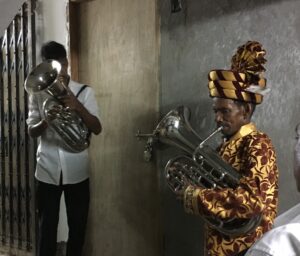
But, by then, the British had already been divvying up the subcontinent for decades. In her book The Spoils of Partition: Bengal and India, 1947–1967, Chatterji details how, since the late nineteenth century, the Indian census, taken once every decade, “counted Britain’s Indian subjects and classified them according to religion, community and caste.” Not only did this introduce notions of separateness or division among people who’d lived together for generations, but the British census also laid the groundwork for Indian political representation based on religious identity.
Particularly in Kolkata, where vicious fighting began a year before the official transfer of power, inherited traumas of Partition remain. In my writing class at Presidency, among students born in the late 1990s, Partition was the most common essay topic, as individual families and the country as a whole continued to grapple with a legacy of fear, loss, and unforeseen cruelty. Though violence against Muslims—on the streets, in the trains, and across the countryside—remains “haphazard,” in a contemporary India struggling under Hindu nationalist power, that violence is also anything but random.
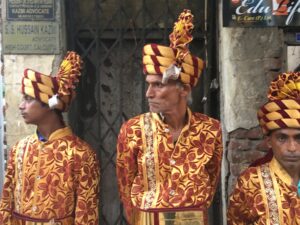
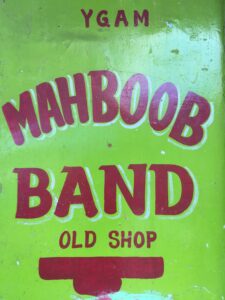

In July, I met Shweta Jaiswal, a twenty-six-year-old woman on MG Road with her mother, confirming a marching band reservation for her November wedding. “My in-laws requested the band,” Jaiswal said, explaining that the price of the marching band was part of her dowry. “The groom will dance at the bride’s expense,” she told me, laughing. But the band was important, she continued with sincerity, echoing the perspective I’d come to hear over and over again: “Since it’s been carried on for generations, the tradition has become a ritual; it’s important to uphold.”
The dependence of Kolkata’s Hindu majority on the Muslim minority is neither rare nor unique to marching bands. Much of the entire Indian economy relies on livelihoods determined by caste, creed, and inheritance. Tailors, butchers, and subji-wallahs (vegetable sellers), for instance, among countless other workers, tend to be Muslim, and no one would think of not buying eggplant or chicken or new clothes. And yet, in the marching bands, I also glimpsed something more significant than simply providing a service. This veneration, this honor, this “duty,” as Pappu Mahboob said, to not only respect these Hindu traditions but to nourish them—this came in powerful contrast to the Hindu nationalist narrative, in which Muslims are accused of, and sometimes killed for, disparaging Hindu culture. As the Hindu bride-to-be Shweta Jaiswal underscored, the custom of the marching band at the baraat has become a ritual, more than a ceremony or a soundtrack.
In July, it was the month of Shravan, a time of pilgrimage and austerity, when many observant Hindus refrain from drinking alcohol and there is often a hiatus in wedding celebrations. Although I did attend one small performance then, for a Hindu wedding, with Sabir’s India band, in a rundown but beautiful big pink hotel, with an inner courtyard and a fountain without water, there was no dancing or procession. The performance was quick and understated, and mostly I just listened to the echo of the drums and the clarinet off the pink balconies enclosing the courtyard, the railings draped with drying saris. Earlier that day, Master Sabir had confided in me for the first time his uncertainty about the future. His sons would not join India Band, he said, though it was unclear if this was a consequence of their failure or their accomplishment. “Young people are more interested in instant success,” he said. Once kids get an education, he shrugged, “they want something else.”
Later that month, on a sweltering Friday night, I joined Pappu Mahboob and his band for a Muslim baraat. (Wedding processions are customary throughout South Asia, among Hindus, Muslims, and Sikhs alike.) We met at his shop before sunset while eight musicians dressed each other in thick gold and maroon brocade and white canvas sneakers.
The band went ahead, carrying their instruments, and it was dark by the time Mahboob and I set out on foot, though the temperature was still in the high nineties. We headed east on Mahatma Gandhi Road, past the block on which every stall sold handmade wedding invitations. I loved this part of Kolkata, where the lanes that branched off the main drag were lined with harmonium makers, esoteric bookstores, ice shops, and antiquated Communist hangouts, with framed pictures of Che and Mao and Lenin around empty tables with plastic tablecloths.
At some point, though, we turned north, and I no longer knew where we were. I hadn’t been able to find a translator available that night and was relying on my own Hindi, which I more or less exhausted after the first two kilometers. Though the crowds did not thin, the makeup of the crowd changed. More women with more babies on their laps were begging along the sidewalk. The few other women we saw were covered, many wearing full chador, until they too disappeared and there no longer seemed to be any women at all. Rearranging my dupatta over my head, I followed Master Mahboob through a labyrinth of unpaved gullies. As densely populated and underresourced as much of Kolkata is, by the time we arrived for the performance, it was evident that this neighborhood, with its unfinished cinder block buildings and windows without glass, was especially impoverished.
Under a heavy tangle of crisscrossed electrical wires, the band members waited to perform, their golden turbans splayed out like origami fans. Tiny boys in tinier undershirts gathered in anticipation. A man in a long, white kurta pushed a rusted Rollick ice cream cart through the crowded lane.
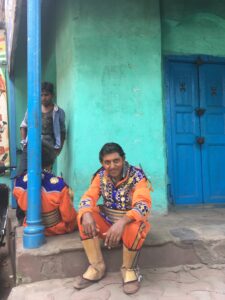
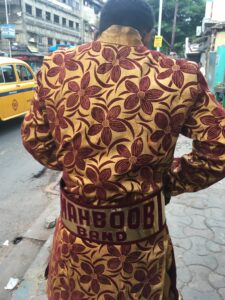
I eventually followed the band up a stairwell to the bare second-story landing of a nondescript apartment building. Here, the music kicked in with what I later learned was a Sufi devotional translated to the brazen spectacle of a marching band that was marching in place. Under the fluorescent tube lighting, the Qawwali “Bhar Do Jholi Meri” echoed off the concrete. Instead of the drone of the harmonium or the dreamy build of the vocals that usually create momentum in a Qawwali, the trumpet was insistent, the tubas buoyant and determined. Cymbals clashed, metal maracas shook, and the saxophone player played like his life depended on it. Traditionally, the lyrics beseech the Prophet to “fill my bag,” so the devotee, the singer, does “not go back empty-handed.” But even without the vocals, the supplication was clear, and I imagined the groom wondering about his future, praying for his happiness. Not wanting to be left empty-handed.
Initially, when Master Mahboob invited me that night, I’d hesitated—not because I hadn’t wanted to come but because I’d thought a Muslim baraat was a different story. Immersed as I’d been in the seemingly intellectual dissonance, in twenty-first-century India, of Muslim musicians performing at Hindu celebrations, I’d neglected what caught my attention in the first place—the energy of the music itself, the very reason for its endurance.
On the landing, the drums and trumpets transformed this bleak hallway into something alive and extravagant, something hopeful. In the splash of the clarinet and the wallop of the tuba, the joy of the music caught me off guard. After thinking so much about the violence and degradation used to dehumanize people, I was overcome, in that moment, by the ways that the music jolted the atmosphere with something shared and immediate and emotional. Something altogether human. Surrounded by the band, I felt the drums in my heart.
That night would be the last time I saw Master Mahboob. In August, I returned to the U.S., and, overnight, India overturned seven decades of the constitutional autonomy of Muslim-majority Kashmir while also escalating its military occupation and clamping down on the ensuing dissent. A few months later, the BJP passed the Citizenship Amendment Bill, which prohibits Muslim refugees from seeking asylum while fast-tracking those of other faiths. The government simultaneously moved ahead with its proposed National Register of Citizens (NRC), which supports Hindus and other non-Muslims in retaining citizenship, even if they lack documentation, but threatens Muslims who lack papers with statelessness, even if they’ve lived in India for generations. Though massive, peaceful protests, by people of all faiths, spread across India, in late February of 2020, Hindu nationalist mobs, abetted by police, ransacked areas of northeast Delhi in reprisal for the protests, ultimately killing at least fifty-three people, primarily Muslims.
A few weeks later, in March of 2020, COVID-19 earned the moniker “the CoronaJihad,” after a large group of Muslims tested positive in the early weeks of the pandemic. India’s initially lax attitude toward the virus was followed by an abrupt nationwide shutdown, leaving millions of the poorest day laborers without any income at all. Innumerable workers, stranded and homeless in cities far from their villages, began to walk hundreds of kilometers home. Then came the devastating “second wave” in the spring of 2021. Though poverty cuts across geography, faith, and caste in India, the pandemic will inevitably continue to exacerbate the downward mobility of many of the country’s most vulnerable, including Dalits (formerly known as “untouchables”), Adivasis (indigenous people), and Muslims.
Currently unable to return to India or contact the musicians, I cannot say for certain how the bands of MG road have fared in the years that have now passed. During the strictest phases of lockdown, large gatherings were prohibited, weddings were limited to a small number of guests, and it’s difficult to imagine how or if the musicians were able to earn any income. I don’t know if Masters Sabir and Mahboob returned to their villages in Bihar, joining the vast numbers of people who left the cities, or if they’ve stayed in Kolkata, preparing to ride out the anticipated third wave.
The image that continues to resonate with me, however, is from that hot, humid night on the landing, under the tube lighting, with the Mahboob Band. And how, after the first few minutes of music, a pack of kids jostled their way up the stairs. One little boy, with dark kohl around his eyes, was wearing a thin yellow kurta and a knit skullcap. He stood still in the corner, observing, until some irrepressible delight erupted inside him. He couldn’t have been more than seven, but he danced with every bone in his body. He danced like there was nothing to lose. He danced like there was nothing to fear.
Preetam Bhadra and Sumana Ghoshal contributed additional research and translation.
Photos courtesy of the author.
Liesl Schwabe‘s essays have appeared in The New York Times, The Washington Post, the Los Angeles Review of Books, LitHub, Words Without Borders, Creative Nonfiction, The Rumpus, and Off Assignment, among other publications and anthologies. A 2018–2019 Fulbright-Nehru Scholar in Kolkata, India, Liesl currently directs the writing program at Yeshiva College and lives with her family in Western Massachusetts.
